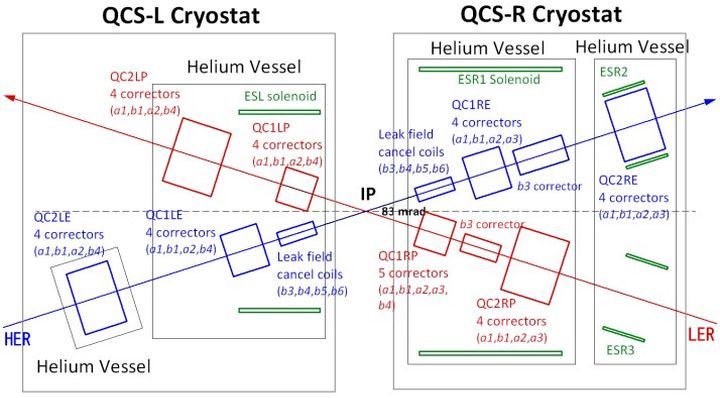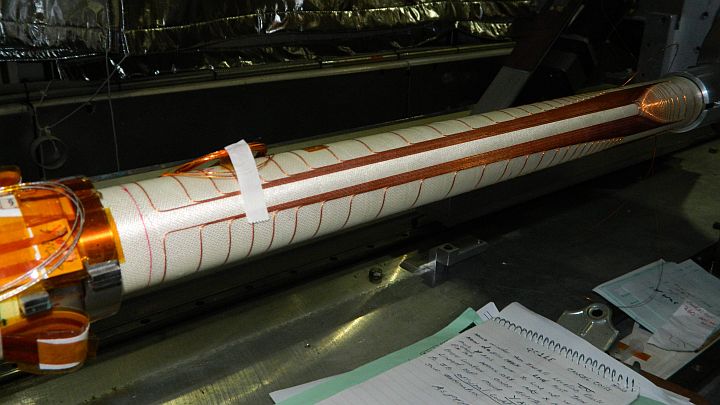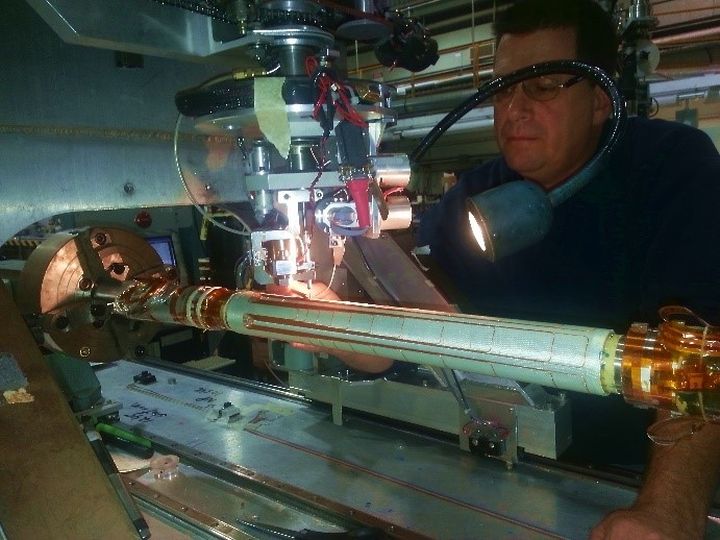Corrector Magnets for SuperKEKB IR Magnets
Overview
The Magnet Division has built superconducting corrector magnets for use with the IR quads in the SuperKEKB project to upgrade the electron-positron collider at the Japanese laboratory, KEK. Each side of the IR needs five correctors. Each corrector contains multiple harmonics; each harmonic has one or more layers. No two correctors have the same design. Special “cancel coils” have been built to cancel fields from magnets that guide the adjacent beam. The fields of the cancel coils vary along the axis of the magnet. The correctors built built using the Direct Wind facility. KEK supplied the NbTi superconductor and precision support tubes. Magnetic field measurements at room temperature were made at BNL.
Technical Details
The electron-positron collider at the KEK laboratory in Japan is being upgraded to produce much higher luminosity (collisions per hour). The upgraded collider, named SuperKEKB, contains 43 superconducting magnets made at the Direct Wind facility of BNL’s Superconducting Magnet Division. (“B” denotes the physics focus: the properties of particles containing a “b” quark.)
In particle colliders such as KEK, RHIC, and LHC, two beams of particles travel at nearly the speed of light in roughly circular paths. At several places, the paths of the two beams cross one another, producing collisions. [see line drawing, below] The colliders use the special magnets nearest the collision point to focus (squeeze) the two beams to the smallest possible size at the point of collision to maximize the number of collisions. These magnets are called IR magnets. (IR stands for Interaction Region.) Superconducting magnets generate higher magnetic fields and, therefore, stronger focusing and smaller beams, than conventional magnets (e.g., those in the AGS).
The principal magnets in the IR are quadrupoles. (Magnet names denote the number of poles in a magnet; for example, a bar magnet has poles at its two ends and is a dipole magnet.) IR regions also contain several different types of corrector magnets (e.g., dipole, sextupole, octupole). These are used to correct errors in the fields of the quadrupoles. For SuperKEKB, KEK built the quadrupoles and BNL built the correctors.
There are several reasons why the unique capabilities of the Direct Wind facility made it the best place to build the corrector magnets. Special purpose codes and precise tooling allow the positions of the NbTi superconducting wires to be sent directly from the accelerator design PC to the PC-controlled machine that winds the coils. The coils are wound directly on support tubes, without the need for special tooling such as that used for the RHIC or KEK IR quadrupoles. The design code can adjust the design to compensate for some out-of-tolerance parameters in the support tube (e.g., field perturbations due to magnet leads, offset or out-of-round and other fabrication errors in the surface of the winding support). The Direct Wind process reduces cost while allowing individual designs to be made for each corrector. Further, the Direct Wind facility can wind coils of different types (e.g., dipoles and sextupoles) on top of one another [dipole corrector coil]. Winding multilayer correctors reduces the distance along the beam path needed for the correctors, which increases the luminosity and reduces cost. For SuperKEKB, 43 correctors were wound on ten support tubes.
Radial space in the IR region is also precious. Traditionally, magnet poles are wound one at a time. For each pole, the connection of the coil to the power supply must pass over the surface of the completed coil, requiring as much radial space as the coil itself. A special method of winding coils, called “Serpentine,” was developed to eliminate the radial space needed to connect to the inner coil lead. In a Serpentine magnet, the coils are wound from a single length of superconductor in a sequence that allows connections of the power supply to be made in the same radial space as the coil.
Some correctors required two or more layers to generate the strength of magnetic field needed. For such correctors, magnetic field measurements can be made after each layer is wound. The design code’s flexibility allows the next layer to be designed with harmonics that compensate for any errors in the previous layers.
A unique coil design capability was developed for the SuperKEKB correctors. Except at the coil ends, the strength of the magnetic field is normally the same along the length of a coil. However, the size of the beams in the IR region changes significantly along this length, so the design of such a corrector is a compromise. In addition, the two beams are so close that there is no room to install a layer of iron between them. (Usually, iron is used to block the quadrupole field in one beam so that it doesn’t affect the adjacent beam.) For the KEK magnets, the capability of the design code was increased so it would perform the function of an iron separator. To do this, the strength of a “leak field cancel coil” is varied along its length in a precise way by returning current at different locations along the coil pattern [leak field cancel coil photo]. With the aid of this special capability, all correctors met the SuperKEKB magnetic field requirements which were much more stringent than normally expected for corrector magnets.
To assure that the correctors reach the design field, spaces between the windings of each layer are filled in with a flexible insulator. After one or two layers are wound, the coil is overwrapped with a fiberglass-epoxy mix which is then cured. These steps are done in order to limit the motion of the conductor due to electromagnetic forces. (Conductor motion can produce quenches which would prevent the magnet from reaching operating current.) All SuperKEKB correctors reached operating current without training.

Line drawing of SuperKEKB interaction region magnets.

Dipole Corrector Coil

Leak field cancel coil being wound by BNL technician Thomas Van Winckel.


